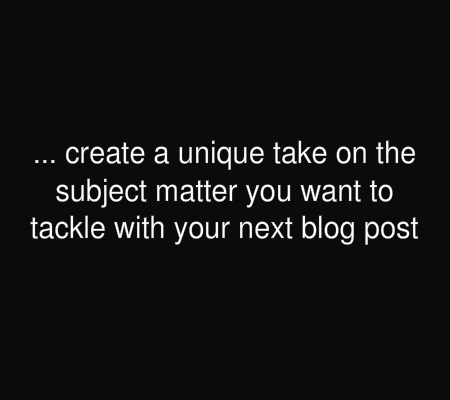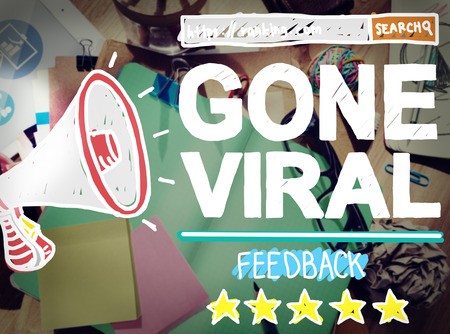
The written word has super powers.
Now a blog post might not fight crime in the middle of the night or rescue people in peril, but engaging content will be a superhero for your site.
Whether you are publishing an online journal of your journey in life or you’re a Fortune 500 business with billions of dollars in revenues, the ability to create engaging content can help you consistently grow your audience.
That’s why knowing how to write a good blog post is such an essential skill right now.
Anyone can throw a few words together to create a blog post.
What you need to do is give those words the super powers it needs.
This guide will show you how you can do just that.
#1. It always starts with the fundamentals
[box type=”note” style=”rounded”]It cannot be overstated: good spelling and grammar are essential to bring the best out of your blog posts.[/box]
The modern reader can be forgiving of an error here and there, but your post shouldn’t be riddled with basic composition errors.
Basic sentence structure fundamentals are also needed for the modern blog post.
You’ll also want to consider these 3 key points.
- Limit run-on sentences. Try to keep each sentence as an independent thought. Compound sentences are fine to use here and there, but don’t use them all the time. By limiting run-on sentences, you’re creating variation within your structure that keeps your content interesting.
- Choose the Oxford comma… or don’t choose it. Be consistent with this. The Oxford comma is used when separating three items ? i.e. peanut butter, jelly, and bread. You could also structure it without the second comma ? i.e. peanut butter, jelly and bread. Choose one and stick with it.
- Use more than one spellcheck. The spellcheck function on your word processing program is only as good as the dictionary you’ve programmed into it. Consider using other programs to check your document. A service like Grammarly can also be useful to check for consistency within your blog post.
As you write more posts, you’ll find that the fundamentals will feel like they’ve become second-nature to you.
It is still important to check for these things before you publish, even if you are an expert.
Even the best writers will say ?there? instead of ?they’re? from time to time and miss it on the first draft.
?
#2. Tell your story

Authenticity within your written words will always be what draws readers into your content.
To create engaging content, this means you must tell your story.
You must be willing to share how you feel so that those who are reading your blog post can get a glimpse of who you are.
Authenticity takes readers into a deeper place and lets them feel like they’re getting to know you.
In order to tell your story, knowing how to write a good blog post means hitting these specific key points every single time.
- Write about things that really matter to you. If there is no passion behind your words, then most readers of your post are just going to skim it to find useful bits of information and then discard the rest of it. When you’re passionate, then you’re telling your readers something that is important.
- Understand that you won’t be able to please everyone. You can give some people undeniable facts, like the sky being blue, and they’ll still disagree with you. When you write a blog post, write it for you and do your best to find peace with the idea that not everyone will agree.
- Keep your story positive. This doesn’t mean every story needs to be a positive one. It’s hard to talk about the death of a loved one, going bankrupt, or enduring a foreclosure with a smile on your face. What you can do, however, is offer a glimpse of hope at the end of your story. This will turn even the most negative situation into a positive example for your readers.
Sometimes it can be difficult to tell your story.
Sometimes you might not want to be that personal with your blog.
If you’re unwilling to offer up a picture of who you are as the composer of words, then readers will be more unwilling to interact with your blog, business, or brand.
?
#3. Don’t underestimate the power of the opening line
When you think of great literature, what authors come to mind?
[box type=”note” style=”rounded”]Maybe Mark Twain, Agatha Christie, JK Rowling, Shakespeare, Tolstoy, George Orwell, Hemingway ? even Stephen King perhaps.[/box]
What do all of these authors have in common?
An understanding of how powerful an opening line can be with the right hook.
Here are just a few examples for you to consider.
?Happy families are all alike; every unhappy family is unhappy in its own way.? – Tolstoy
?It was a bright cold day in April, and the clocks were striking thirteen.? – Orwell
?You don’t know about me without you have read a book by the name of The Adventures of Tom Sawyer; but that ain’t no matter.? – Twain
The American Book Review has put together a list of the 100 best first lines in history for even more examples.
Each opening line has one main idea: to capture the attention of the reader from the very start.
There are four primary ways that you can do this when your goal is to create engaging content for your blog.
- Offer a quote. When you offer a quote from someone who is well-known in your industry or to the subject matter you’re going to discuss, then you give your blog post instant credibility.
- Offer a statistic. 73.6% of statistics on the internet might be made up, but verifiable facts with link sources or citations can prove your expertise to the reader.
- Ask a question. There’s something that all questions imply they have: an answer. Let your blog post be the answer to the question you believe your readers are thinking about.
- Tell a short story. That’s right ? you can tell a story in just an opening sentence or two. ?I was standing outside, my feet in the grass and sun warm on my face, and a thought struck me: what if everyone knew how to write a good blog post? How would that change the world??
Maybe that should have been the opening line of this content, come to think of it…
The point is this: you’ve got to hook people by immediately engaging with them from the start of your post.
Then each sentence afterward must continue that hook.
You must keep driving forward with your content.
Without the hook and drive, your blog post is going to struggle to survive.
?
#4. Keep your language at an appropriate level
 The average person who is going to be reading your blog post won’t have a Ph.D in literature or your language of choice.
The average person who is going to be reading your blog post won’t have a Ph.D in literature or your language of choice.
They’re just regular folks who are looking for some information and think you can provide it for them.
You don’t have to be a walking thesaurus, even if your aa is hot and you want to absquatulate because you have an adscititious appointment elsewhere.
Maybe you know that aa is a type of volcanic lava and to absquatulate means to leave quickly, but not everyone will know that.
When you make a reader feel uncomfortable? – or worse, stupid ? then you will sour their experience with your blog.
Best case scenario? You’re perceived as pretentious.
Worst case scenario? People stop reading your blog.
So here’s the idea: keep your verbiage at an appropriate level for who you believe reads your blog.
The goal isn’t to ?sound? smart.
The goal should be to show your experience in a way that is understandable to virtually anyone who would read your blog post.
You can do this by using words that most folks are going to know.
You can have an ?additional? appointment elsewhere and that’s fine to say.
Good leaders can explain technical concepts in a way that most people will be able to use for their own skill development.
When you can do that with the written word, then it will have the super powers needed for a good blog post.
#5. Analogies are wonderful things
Analogies are how new ideas can be understood by the average person.
This blog post started with an analogy.
You probably use them in the stories you tell all the time without thinking about it.
Yet if you want to know how to write a good blog post, then you’ve got to start thinking about the actual structure of the analogies you use within your content.
According to Scott Young, ?A good analogy is a compromise between two conflicting goals: familiarity and representativeness.?
This means that the analogy must be able to relate to something we all generally know about.
So I might say that blogging is like trying clean your house.
You can make a good impression with a clean house on one planned visit, but what about a surprise visit?
Your house doesn’t stay clean unless you keep working at it, again and again, to make sure everything is picked up and put away.
Still working on that one.
#6. What will it take for you to be unique?

Even if your idea isn’t a new one, you can create engaging content for your blog by offering a unique take on an old idea.
There’s always a new angle that can be found, even if something like ?knowing how to write a good blog post? has been written about thousands of times before.
There are some easy ways to create a unique take on the subject matter you want to tackle with your next blog post.
- Be specific about the subject material. Instead of writing about how to play video games, write about how you developed your impressive hand/eye coordination on a Commodore 64 while growing up.
- Talk about your specific experiences. Your perspective will always be unique. When you discuss the pros and cons of your specific experiences, you’ll be able to offer insights that your readers may find to be useful.
- Go negative. Although positive words tend to be well received, the power of negativity should not be ignored. It’s sort of like deciding to follow the Dark Side. Misery loves company, so you can take the opposite side of a debate on any subject and be able to own it as something which is unique.
One of the best ways to be unique is to use your sense of humor to convey the key points you’re offering.
Humor is something that can turn some people off, maybe even offend them, but your humor is also unique to you.
Humor can also be the source for your writing super powers if you have the courage to let it be.
You don’t have to be a stand-up comic to include humor within your content.
All you need to be is yourself. If that means you’re more like an Albert Brooks movie than an Adam Sandler movie, then there’s nothing wrong with that because you’re being authentic.
?
#7. Stop trying to make your content go viral

Sure. We’d all like a blog post to go viral one day.
A lucky few bloggers have had this happen.
With creative content, you really have no control over whether or not your blog post will actually go viral.
There’s a trap that many writers fall into where they start trying too hard to get their content noticed, shared, and multiplied.
Then, when the post doesn’t go viral, the writer gets frustrated.
That frustration gets put into the next blog post written.
Readers pick up on that frustration, feel like they’re being blamed for what has happened, so they stop reading.
The writer then gets frustrated by fewer unique visitors within their analytics when they check the figures.
So that frustration gets put into the next blog post.
And so the cycle continues.
Here’s a different perspective to consider: if you can change one life, then you can change their world.
If you can change several individual worlds, then you can change a town. A state. A region. A nation. And eventually you really can change our planet.
Maybe you won’t get famous by doing so.
It might not give you extra advertising revenues or allow you to sell advertising space.
What it will do is help you to create engaging content that people can use immediately.
This is ultimately what it means to write a good blog post.
You’re writing it for the one person who will read it, understand it, and apply it.
Keep it in that perspective and you’ll discover the super powers within your written words more often.
#8. Transform casual visitors into excited visitors

On any given day, ?many visitors are not actually going to read the online text.
Most people are just going to scan the blog post you’ve written to pull out a few key points that you’re trying to make.
They’ll spend a couple of minutes on the post, maybe visit a couple additional posts if they found something valuable, and then move on.
According to Neil Patel, ?If you optimize your posts properly, you can increase the time readers spend on your page. And, to a large extent, more time equals more engagement.?
We’ve discussed how to create engaging content, but your written words need a little help to maximize their super powers.
Pictures, graphics, and other meaningful visual content is the power enhancer that your blog post needs.
A blog post that has just one image has the potential of doubling the amount of traffic it can direct to your site.
If you include one image for every 300 words of creative content you publish, then you’ll be able to potentially double that traffic for each additional image.
So let’s do the math on the potential maximum traffic just one post could receive.
- A blog post that has 500 words of the best content you’ve ever written = 100 unique visitors.
- Including one meaningful image with that blog post = 200 unique visitors.
- Including two meaningful images with that blog post = 400 unique visitors.
Now keep in mind that the simple exercise in the key points above is the maximum traffic the post may generate for example purposes only.
Some blog posts might only get 25 unique visitors because you’ve just started writing.
A well-established blog might see 2,000 unique visitors.
Then there’s the Golden Ratio to consider.
When an article uses an average of 1 image for every 75-100 words, it has the highest potential of being shared.
In 2014, the top 6 most-shared articles that Guardian published were picture lists.
Buzzfeed had a picture list shared 2.5 million times.
So yes ? the written word provides super powers.
Without images to accompany those words, however, you may be providing kryptonite to your creative content without potentially even realizing it.
[box type=”note” style=”rounded”]140+ Sources of Free Images[/box]
#9. It’s important to know your numbers
People like numbers.
People also like headlines.
According to David Oglivy, who in 1962 was named by Time as ?the most sought-after wizard in today’s advertising industry,? people are 5x more likely to read the headline of your content as they are the body of the content itself.
Oglivy was an internet legend during a time when the internet would have blown the average person’s mind.
His advice is still very relevant today.
Kissmetrics has put together a wonderful blog post that go over his 7 tips for writing copy that sells and it’s a wonderful read.
Numbers work. They work for blog posts, magazine headlines, and even in the title of TV shows.
There are some rules to try to follow if you’re trying to write a good blog post that people will remember.
- Keep your key points to a minimum number. The average person is only going to remember 3-7 key points from your headline. In some cases, including more than that can actually turn some visitors away because the headline makes the content feel intimidating.
- Obscure numbers can grab someone’s attention. Take your average Google search and you’ll find headlines that offer 5 tips, 7 tips, or 10 tips for whatever subject matter is being talked about. There’s nothing wrong with that, but it doesn’t help the content to stand out. Sometimes an obscure number of tips, like 14, will entice someone to click on the link to your blog.
- Adjectives are also important. You have 14 tips for what? Running fast? [Insert yawn here.] Your adjectives need to be seductive. Thrilling. Like you’re encouraging the reader to take a bite out of the forbidden apple. ?Running Incredibly Well? is so much better than ?Running Fast.?
Jeff Goins has come up with an ingenious formula for developing catchy headlines.
It goes like this.
[box style=”rounded”]Number or Trigger Word + Adjective + Keyword + Promise[/box]
This formula can be applied to any content.
When you’re using this formula, it is important to remember that most readers don’t like it if they feel like they were tricked into clicking on your blog post link.
Your content needs to be worth their while.
When it is, they won’t regret the time spent on your blog.
That means you’ve created engaging content and an overall good blog post.
#10. Subheadings: why are they still so important?

(Your subheadings must stand out just like the umbrella above)
As much as you’d like to bring engaged readers on a reading journey from start to finish on each blog post, it just isn’t going to happen.
You can know how to write a good blog post that has powerful content contained within it and some readers will still skim it.
This is why subheadings are still so important, even as SEO efforts have turned to value more than keyword placement and density.
It’s a way to break up the content into smaller chunks so that readers can absorb super powers contained within the most important parts of your blog post.
There are three types of subheadings that you can include within your content to make it more engaging.
- Transitional Subheadings. This type of subheading helps readers transition from paragraph to paragraph within your blog post. It shows the reader how each part of the post is related to each other.
- Informational Subheadings. This type of subheading helps to explain the content that follows it. These are useful for summarizing difficult concepts because it gives the reader one central idea to consider when reading the paragraphs which follow.
- Persuasive Subheadings. This type of subheading summarizes the arguments you’re making within the blog post. The goal is to reinforce your position so that the reader will be more inclined to agree with you.
Size matters when it comes to your subheadings.
If you want to make them pop, then they need to be of consistent sizing throughout your content so it doesn’t encourage the reader to just look at them and not the rest of the post.
If you use h2 or h3 settings, then you’ll be able to make the subheadings feel inclusive.
Try to stay away from h4 because it makes the subheading feel more like bolded content to the reader, which gives the text a different meaning.
?
#11. Blockquotes and content boxes are your best friends
[box type=”note” style=”rounded”]If you want to know how to write a good blog post, then you need to think about the structural elements of blockquotes and content boxes.[/box]
These are perfect for the times when you want to make one very specific point to the reader.
This is because it makes your text stand out by formatting it in a different way.
Block quotations use an indentation to change the perspective of the content.
Content boxes can even have background fill color to make them visually stand out from the rest of the blog post.
There are a number of ways that you can even customize the look of your blockquotes and content boxes to personalize your site.
[quote]A blockquote or content box can make the super powers of your written words really pop for the reader.[/quote]
They can also cause problems for your post because the readers will judge the value of your post based on the value of this one specific bit of content.
To get the most power possible out of this content option, it is important to know when they should be considered for use.
- Blockquotes are useful for times when you need to have an extended source quote in your text. Any quotes that are 3-4 lines in length or longer benefit from this format.
- Content boxes are useful for reinforcing the one key point of your blog post. If you were writing an essay, then the thesis statement would go into the content box.
- Both formatting options are useful for when you want to really emphasize something you are saying within the flow of your content.
[box type=”note” style=”rounded”]It is a good rule of thumb to use one blockquote or one content box for about every 250 words of text that you write.[/box]
If you’re including bullet points within the body of your text, then you may wish to extend the one blockquote or content box rule to every 500 words instead.
This way your content doesn’t confuse or overwhelm the reader.
Are You Ready To Create Engaging Content?
There are more than 2 million blog posts that are published every day.

Source: http://www.digitalbuzzblog.com/infographic-24-hours-on-the-internet
The written word can have super powers, but only when the focus of the blog post is on the reader.
How you create something that is engaging and powerful doesn’t have to be complicated or controversial.
Sometimes the best thing to do is to stay simple and focus on telling your story.
Be authentic and you will be able to start building relationships with your readers.
Hopefully you’re excited about writing your next blog post with this information in mind.
As an extra bonus tip, it’s often a good idea to have your blog posts professionally edited if you can afford that cost.
If not, try editing your blog post by reading it out loud to yourself to catch some of the errors that inevitably creep up in a first draft.
And if you catch an error later on, it’s okay to edit that post to remove it.
Some readers may have seen the error, but the quick edit will prevent more readers from seeing.
Anyone can be a writer. Anyone can be an expert.
Not everyone can build a loyal audience through the super powers of their written words.
Today that can be you.
Have you incorporated any of these steps into your blog posts or creative writing? If so, what results did you see from the changes you made?